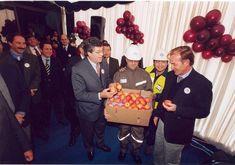
Chile’s fresh-fruit industry celebrated a significant milestone last week - its first-ever 200 million case export season.
A commemoration of this unprecedented event was hosted by Ronald Bown, president of exporters’ association Asoex, in Valparaiso, Chile’s principal point of embarkation for fresh fruit.
Chile’s fresh-fruit offer is led by table grapes, accounting for roughly half of all fruit exports, followed by apples, kiwifruit and stonefruit. These fruits are crucial to Chile’s success as a world leader in fresh fruit exports, but other locally produced varieties such as avocados, blueberries and clementines are also making great headway in international markets.
Chile’s fruit is exported in almost equal proportions to North America, the EU, and Asian and Latin American markets, and is enaten by consumers in more than 70 nations around the world.
The 200 million case benchmark comes after more than 30 years of intense competition with other southern hemisphere fruit exporting nations, principally South Africa, New Zealand and Australia.
Chile, is now the biggest global exporter of fruit in the southern hemisphere. Asoex said it has “jumped to its leadership position by adapting to quickly changing market demands and by developing a modern, sophisticated infrastructure emphasizing traceability and good agricultural practices”.
The market adaptation is best seen by the industry’s quick move into bi-colored apple varieties and the Red Globe table grape variety - two fruit varieties that didn’t exist in the country 15 years ago. Bi-colored apples largely replaced traditional red apples, which have lost favour with consumers in recent years; while Red Globe - originally exported to the Asian market, has become a success in North America and the EU too, to the extent that production now exceeds production of traditional mainstay Thompson Seedless.
“Chile’s decision more than a decade ago to promote and implement a nation-wide "good agricultural practices" (GAP) regime for its fruit growers and exporters has anticipated world-wide concern about the health and safety of fruits and vegetables. GAP practices are now in force in more than half of Chile’s fresh fruit farms and businesses, and guarantee - by way of documentation and constant review - that Chile’s fresh fruit exports meet or exceed all international standards,” said Asoex.
“Chile’s leadership in these two critical issues, together with its swift adaptation to consumer demands, has resulting in the landmark event that is being celebrated today. It is an event that workers and leaders throughout the nation should celebrate with us. The industry’s success is, after all, the results of exceptional teamwork in an ever more competitive world.”



